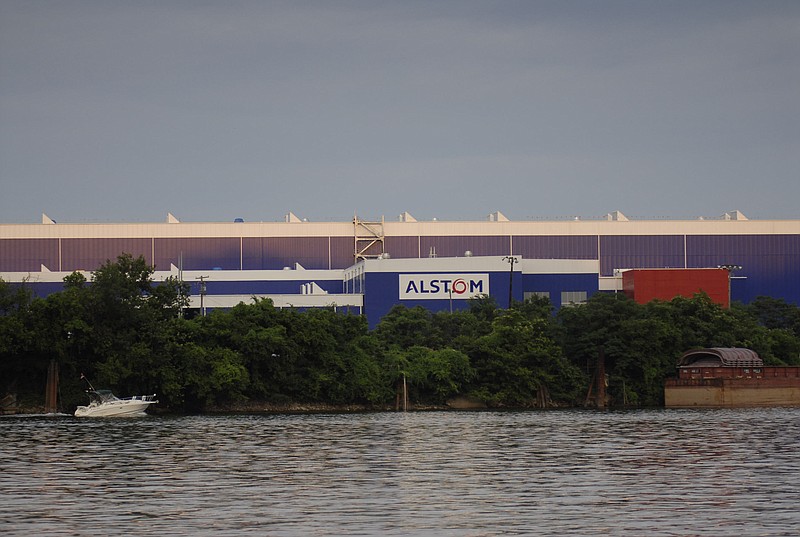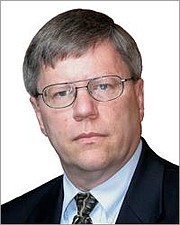The reactor vessels for 57 U.S. nuclear reactors - and many others worldwide - were manufactured by Chattanooga's Combustion Engineering in Chattanooga, once the city's biggest manufacturing employer.
The Chattanooga C-E factory employed more than 5,000 workers during the 1970s and early 1980s. In all, over half the America's nuclear units include equipment made in Chattanooga at the former facility on Riverfront Parkway, which after a series of ownership changes was shut down by GE Power in 2016 after GE bought Alstom Power.
Interestingly, although the Combustion Engineering plant was located only a few blocks from the power headquarters of the Tennessee Valley Authority, the reactor vessels for TVA's nuclear plants at Browns Ferry, Sequoyah, Watts Bar and the mothballed Bellefonte plants were all made by other vessel manufacturers outside of the Tennessee Valley.
Delivering the goods
In the days before FedEx, how did reactor vessels made in the hills of east Tennessee get to locations coast to coast? The Tennessee River winds through Chattanooga and empties into the Mississippi River. Whenever possible, the reactor vessels were lifted onto barges in Chattanooga and floated to the plant sites. For example, the Unit 1 reactor vessel for the Nine Mile Point nuclear plant in Oswego, New York, took the scenic route down the Tennessee River, up the Mississippi River, up the Illinois River and then across four of the five Great Lakes.
In another instance, it took 29 days for one reactor vessel to make the 3,587-mile journey down the Tennessee and Mississippi Rivers, across the Gulf of Mexico and along the Atlantic coast to Plymouth, Massachusetts.
The Unit 1 reactor vessel for the San Onofre Nuclear Generating Station in southern California began its 2,000-mile journey on a barge, was transferred onto a freighter for passage through the Panama Canal, was transferred back onto a barge, and then loaded onto a train car for delivery to the site.
Weighty problems
Not all the journeys were event-free. The Unit 3 reactor vessel for the Indian Point nuclear plant in Buchanan, New York, was dropped on January 12, 1971, as it was being unloaded at the plant. Well, it was not actually dropped. It underwent a so-called "unscheduled descent during its installation" at the plant. An overhead crane rated for 175-tons was being used to lift the 456-ton package of reactor vessel and shipping rig. Somehow, the motor for the 175-ton rated crane became overheated as it was lifting the 456-ton load. The 456-ton load had been raised from its original horizontal configuration to nearly the vertical (i.e., 90-degrees) position when the lift was halted to let the overheated crane motor cool down. The 175-ton crane's hoist failed, dropping the load - or letting the load make its "unscheduled descent" back to the horizontal position.
Scientists from Oak Ridge, representatives of Combustion Engineering in Chattanooga, and workers from Westinghouse huddled to determine whether the unscheduled descent of the reactor vessel resulted in its unscheduled dis-use. They reviewed results from magnetic particle and ultrasonic examinations and concluded the vessel could be used.
Scientists from the Oak Ridge National Laboratory traveled to Buchanan to view the Unit 3 reactor vessel. They heard contradictory accounts as to the position of the reactor vessel when it began its unscheduled descent. Some eyewitnesses said the vessel and rig were about three feet off the ground. Others insisted it was not off the ground at all. Similarly, the scientists received varying accounts of how long it took the vessel to complete its unscheduled decent. Some eyewitnesses reported the descent took 15 seconds. Others claimed the descent went on for nearly 60 seconds. The discrepancies might be attributed to the eyewitnesses making unscheduled departures from the vicinity.
UCS Perspective
The Union of Concerned Scientists has staffed a remote office in Chattanooga for the past eight years. At the time, we knew the city was the location for the International Towing Museum, but did not realize that the city played such a prominent role in the development of nuclear power reactors in the United States. And if making tow trucks and reactor vessels was not enough, but Moon Pies were invented in Chattanooga in 1917.
Chattanooga also has the offices for the Nuclear Division of the Tennessee Valley Authority (TVA), with TVA's Sequoyah Nuclear Plant within sight of downtown. Chattanooga also has the Nuclear Regulatory Commission's Technical Training Center as well as a Westinghouse training facility.
But Chattanooga no longer makes reactor vessels. Combustion Engineering scaled back manufacturing at the factory as demand for nuclear components dwindled in the United States and abroad. In 2007, the nearly-idled manufacturing plant was acquired by French-based Alstom with intentions to make components to support the nuclear renaissance. The factory did not need a first shift, yet alone a second or third shift, to handle all the non-orders for reactor vessels and other nuclear plant parts. The factory closed shop in 2016.
But don't despair. Chattanooga still makes Moon Pies and tow trucks.
Dave Lochbaum is director of Union of Concerned Scientists's Nuclear Safety Project, where he monitors ongoing safety issues at U.S. reactors, testifies before Congress and the Nuclear Regulatory Commission (NRC), and provides informed analyses of nuclear plant conditions and incidents. A nuclear engineer by training, Lochbaum worked at nuclear power plants for 17 years and left the industry in the early 1990s after blowing the whistle on unsafe practices and joined UCS in 1996. He then left UCS in 2009 to work for the NRC as a reactor technology instructor and returned to his post at UCS a year later.

